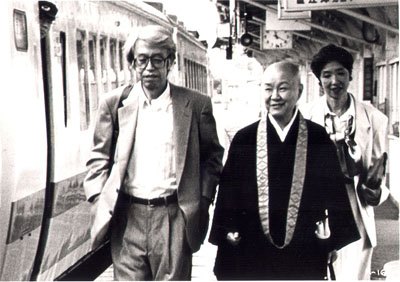| Reviews & Columns |
|
Reviews DVD TV on DVD Blu-ray 4K UHD International DVDs In Theaters Reviews by Studio Video Games Features Collector Series DVDs Easter Egg Database Interviews DVD Talk Radio Feature Articles Columns Anime Talk DVD Savant Horror DVDs The M.O.D. Squad Art House HD Talk Silent DVD
|
DVD Talk Forum |
|
|
| Resources |
|
DVD Price Search Customer Service #'s RCE Info Links |
|
Columns
|
|
|
Dedicated Life, A
Inoue (1925-1992) was a widely-read, left-leaning postwar writer who spurned the Tokyo literary scene, preferring to teach writing at 13 schools he eventually opened between Hokkaido and Kyushu, and sitting as a judge on arguably unpopular panels that included an annual prize given budding burakumin writers. (Burakumin is the outcast social minority of families regarded as "impure" because of their ancestors' feudal-era professions: butchers, leather workers, undertakers, etc. They are discriminated in Japan even today.)
In the film, Inoue enjoys a following of mostly intelligent but lonely middle-aged single women, their youthful beauty now a distant memory, who find his manner and appearance irresistibly sexy. They insist he alone was able to mine a talent for writing and a passion for life they never knew they had. Numerous women admit to having an affair with and perhaps even children by him, even though he's married and despite the fact that he's no better than emotionally indifferent toward them and frequently verbally abusive. En masse they dote on him despite this.
In his writing classes Inoue is mercilessly blunt to his students; he lashes out at their allegedly hack efforts and not once during the film's two-and-a-half-hour running time does he offer a single word of individual praise or encouragement. Nevertheless, Inoue's sycophants seem to revel in the flagellation, apparently inspired by Inoue's stories of growing up in rural coal-mining town, eking out a living as a medium telling bereaved widows that their coal miner husbands died instant, painless deaths deep down in the mines, knowing all the while the very opposite was true.
In the film's final third, Hara gradually learns that many of the stories of Inoue's hard-luck youth and claims about his involvement with the postwar Japanese Communist Party - he insists he was both one of its founders and the first to be expelled from it - are utter fabrications, lies spun to make him appear more worldly and sympathetic, or perhaps to suppress an equally tragic but less melodramatic past. (The latter is suggested by one of Inoue's closest friends, the acclaimed Buddhist nun and writer Jakucho Setouchi.) Hara uses dramatic recreations with actors to show Inoue's fabricated past, a justified technique given how things turn out.
Meanwhile, Inoue's cancer spreads like wildfire. Most of his liver is removed in an eight-hour operation, shown in very graphic detail (and accompanied by dead silence, heightening its impact). Though Inoue says several times that he wants to "live a little bit longer," he stays remarkably active and upbeat throughout the ordeal. However, unlike the discrepancies Hara reveals in Inoue's autobiography, the film itself is rather dishonest on this issue: in an interview which accompanies the DVD, the director admits that Inoue was equally controlling of the filmmaking process, refusing to be photographed when he considered himself too weak or depressed. And so, Inoue throughout the film is the inspiring indefatigable spirit refusing to surrender and yet, tellingly, we see him not at all during his last few months. (He does, however, resort to a highly questionable "doctor" for alternative treatment. The obvious crook calls himself "Dr. Red Beard.")
Video & Audio
A Dedicated Life is presented in its original full frame format in a good all-region transfer that serves the film well. The mono audio is fine, and the subtitles, despite some paraphrasing, are likewise good. As with other films in this series, the DVD keeps defaulting to the no-subtitles option even when you turn them on via the menu screen option, so viewers will have to activate them manually.
Extra Features
The only extra is a pretty good 11-page booklet that outlines the film and includes a short interview with the director.
Parting Thoughts
Ultimately, A Dedicated Life's self-styled iconoclast is less intriguing than the protagonists of Hara's Extreme Private Eros: Love Song 1974 and The Emperor's Naked Army Marches On. Partly this is because he is so self-conscious of his roguish image that he controlled the conditions under which he was filmed, and because of Hara's obvious affection toward him. Additionally, the director lacks the focus that drove those earlier films, perhaps because it was rushed into production when Inoue fell ill. Nonetheless, this is otherwise a fascinating film on several levels, and Highly Recommended.
Film historian Stuart Galbraith IV's most recent essays appear in Criterion's new three-disc Seven Samurai DVD and BCI Eclipse's The Quiet Duel. His audio commentary for Invasion of Astro Monster is now available.
|
| Popular Reviews |
| Sponsored Links |
|
|
| Sponsored Links |
|
|
| Release List | Reviews | Shop | Newsletter | Forum | DVD Giveaways | Blu-Ray | Advertise |
|
Copyright 2024 DVDTalk.com All Rights Reserved. Legal Info, Privacy Policy, Terms of Use,
Manage Preferences,
Your Privacy Choices | |||||||















